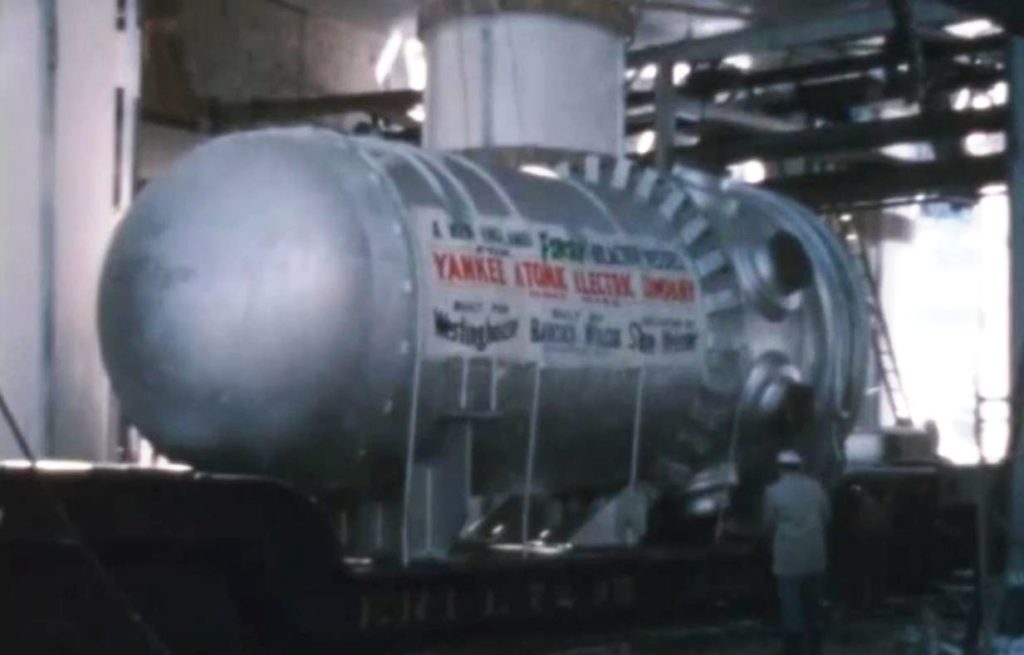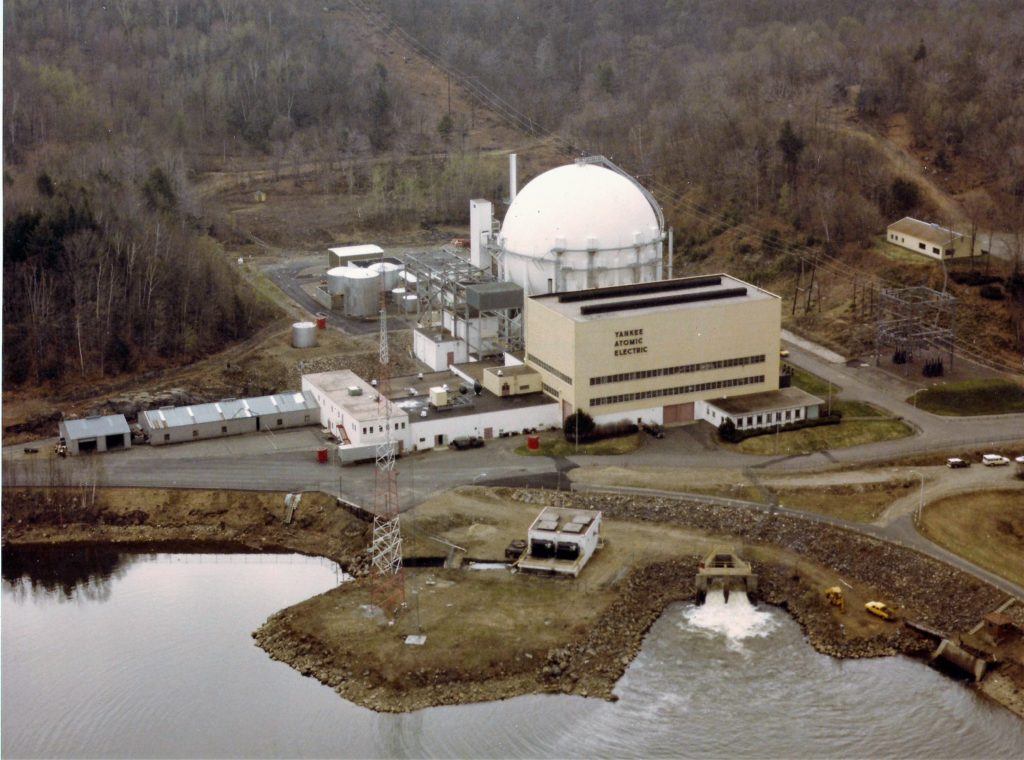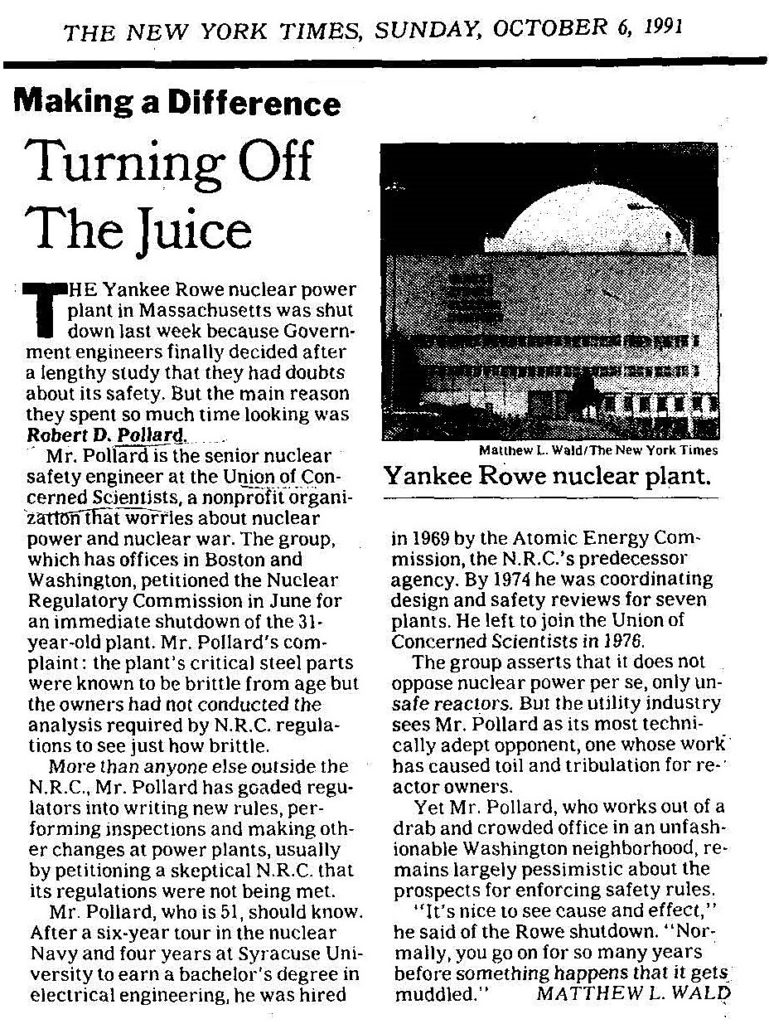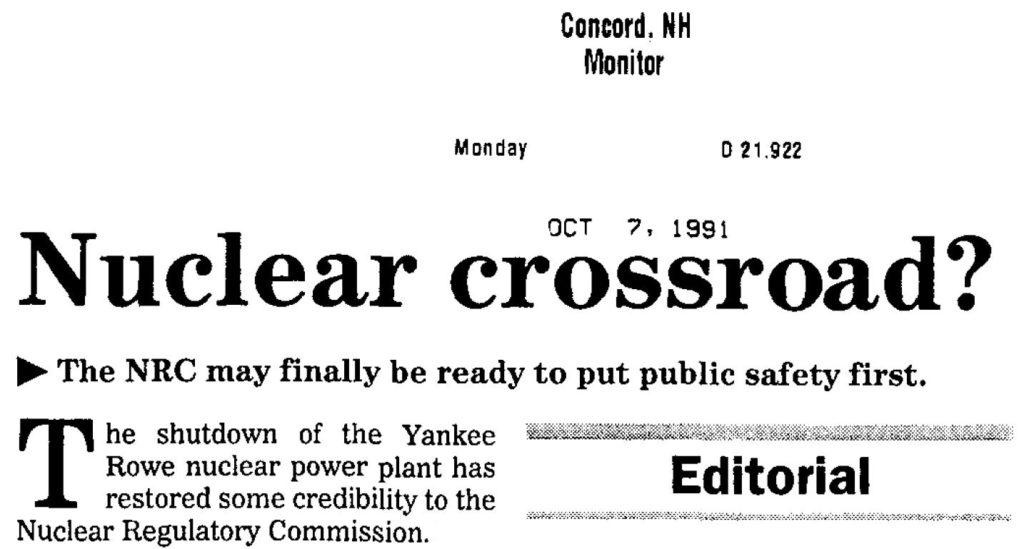Role of Regulation in Nuclear Plant Safety #4
The Yankee Rowe nuclear plant in Massachusetts was a forerunner in the industry pursuing extensions to the original 40-year operating license. But its run for a longer lifetime was derailed when Nuclear Regulatory Commission (NRC) engineers discovered that the plant might not meet current safety requirements. Unable to convince the NRC that the requirements were satisfied after a year of trying, the owner opted to permanently retire the plant after only 31 years of operation.
Yankee Rowe’s History
The Yankee Atomic Electric Company (YAEC) was formed on November 30, 1953, as a joint venture of ten utility companies in New England. On June 6, 1956, YAEC signed the first contract in the Atomic Energy Commission’s (AEC’s) Power Reactor Demonstration Program. This program sought to build and operate a variety of nuclear power reactors, with partial government financing, to advance the country’s nuclear power technology development. Construction began on February 28, 1958, and was completed on May 31, 1960. Electricity generated by the plant was first connected to the offsite power grid on November 10, 1960. YAEC placed the plant in commercial operation on July 1, 1961.
Yankee Rowe featured a four-loop pressurized water reactor (PWR) designed by Westinghouse. The core had a power limit of 485 megawatts thermal but was upgraded to 600 megawatts in 1963. For comparison, the Westinghouse AP-1000 pressurized water reactor under construction in Georgia has a power limit of 3,400 megawatts, nearly six times higher.
Yankee Rowe was shut down on October 1, 1991, due to the NRC’s concerns about the integrity of the reactor vessel. The company notified the NRC by letter dated February 27, 1992, that it had decided to permanently shut down the plant rather than continue the effort and expense of trying to resolve the NRC’s concerns.
Over its 31-year lifetime, Yankee Rowe operated at an average capacity of nearly 74 percent—nothing to write home about considering today’s 90-plus percent capacity factors but a good achievement for its era.
Reactor Vessel’s Role
The reactor vessel for Yankee Rowe was manufactured by Babcock & Wilcox at their factory in Barberton, Ohio. Figure 1 shows the reactor vessel after arriving at the plant before it was lifted into a vertical position and raised into the containment sphere. The containment sphere also houses the four reactor coolant system loops, with each loop consisting of a steam generator and reactor coolant pump.

Fig. 1 (Source: Periscope Film)
The defense-in-depth nuclear safety philosophy employs multiple layers. If one emergency diesel generator is needed to power safety equipment during an accident, then two or more are installed to increase the likelihood that one gets that job done. That approach is replicated across the array of core cooling systems, emergency ventilation systems, and so on.
The reactor vessel is one of the very few defense-in-depth exceptions. Failure of the reactor vessel could drain cooling water faster than the emergency pumps can supply makeup. The entire reactor core is loaded into a metal vessel whose failure has no backup and no assured mitigation. Why? The principle follows Andrew Carnegie’s advice: “Put all your eggs in one basket and then watch that basket.” The reactor vessel gets watched a lot. (Yes, Virginia, sometimes a watched pot does boil.)
Reactor Operating Licenses and License Renewal
The NRC published a notice in the Federal Register on November 6, 1986, soliciting comments about regulatory changes to enable nuclear plants to operate beyond their initial 40-year operating license periods. The NRC sought comments on the duration of extended operation as well as the criteria to be used in deciding whether extension requests should be granted.
In April 1989, the General Accounting Office (GAO) issued a report on license renewal. Congress tasked GAO to examine nuclear plant aging after a worn-out pipe ruptured at the Surry nuclear plant in Virginia and killed four workers. GAO reported that the NRC licensed reactors for operation up to 40 years, but neither the Atomic Energy Act or NRC’s regulations provided for an extension or renewal of the operating licenses. The Department of Energy (DOE) and the Electric Power Research Institute (EPRI) found interest among nuclear plant owners for possibly extending plant lifetimes, depending on what NRC required to obtain that authorization.
The Monticello nuclear plant in Minnesota and Yankee Rowe became the lead boiling water reactor (BWR) and PWR for the DOE, EPRI, and NRC to examine and define a license renewal process. The reactor operating license for Yankee Rowe was initially slated to expire on November 4, 1997. The NRC approved on June 8, 1988, an extension to July 9, 2000. (Because the NRC had not yet issued a regulation for renewing or extending reactor operating licenses, “extensions” of the operating license for Yankee Rowe and several other reactors really did not lengthen the 40-year term of the initial license. Instead, they redefined when the 40-year clock started. Sometimes, that clock started when the reactor vessel was set in place, even though it was several more years before construction was completed and the atom splitting started.)
The NRC pursued a rulemaking process that culminated in the issuance of the Nuclear Power Plant License Renewal final rule on December 13, 1991. While the NRC now had a license renewal rule, it no longer had the lead PWR pursuing license renewal. The owner had voluntarily shut down Yankee Rowe on October 1, 1991, after receiving word that the NRC staff would be recommending to its Commission that the reactor be shut down. The reactor never restarted.
The NRC lost both its lead license renewal plants. After seeing license reprise result in license demise for Yankee Rowe, the owner of Monticello informed the NRC that it put license renewal efforts on hold.

Fig. 2 (Source: Nuclear Regulatory Commission Flickr Gallery)
Reactor Vessel Embrittlement
Yankee Rowe’s reactor vessel was made of metal. Metal expands when it is heated and contracts when it is cooled. During routine operation, the rate at which the reactor power is increased and decreased is controlled to limit the metal’s temperature change to less than or equal to 100°F per hour. This limit minimizes internal stresses as metal parts expand and contract to avoid cracking.
The temperature change limit does not apply during accidents. If a pipe connected to the reactor vessel breaks and drains cooling water, the emergency pumps do not slowly add makeup water to keep the metal from cooling down too quickly. The pumps supply lots of makeup water to prevent the fuel rods from hearing up too much.
The reactor vessels are designed to go from steady state operation at over 500°F to sudden exposure to makeup water as cool as 40°F. Termed “pressurized thermal shock,” it’s not an exposure the reactor vessel is expected to encounter often. But it is a sudden, rapid temperature change the reactor vessel is required to be capable of enduring at least once.
The reactor vessel’s capability to withstand pressurized thermal shock lessens with time. The bombardment of the metal by neutrons during reactor operation—termed reactor vessel embrittlement—hastens the degradation.
Yankee Rowe’s Achilles Heel
It didn’t take long to identify the reactor vessel as the limiting component at Yankee Rowe. The company evaluated a 20-year period past the original 40-year operating license for the reactor, considering the accumulated embrittlement and other degradation factors such as the anticipated number of times the vessel cycles between “cold” conditions during outages and “hot” conditions during full power operation. The company’s evaluations concluded that sufficient margin would remain until at least the year 2020.
The NRC staff did not agree with the company’s assessment. Pryor Randall, an engineer in NRC’s mechanical engineering branch, penned a memo dated September 11, 1990, to Tom Murley, then the Director of the NRC’s Office of Nuclear Reactor Regulation, stating:
Perhaps it is time to quit being polite in our rejection of the licensee’s estimates…. They have been told on more than one occasion that their basis was unacceptable. Our expert consultant, Professor Odette, addressed their arguments in point-by-point fashion and found them to be without merit. I will state here for the record that the licensee’s arguments that coarse grain size negates the effects of irradiation-temperature and nickel content are sophistry, a subtle, tricky, superficially plausible, but generally fallacious method of reasoning.
Without even looking up the highfalutin words, the NRC staff clearly wasn’t buying the company’s claim that Yankee Rowe’s reactor vessel was good to run until 2020.
Predicting the future involves uncertainties. Making matters worse was the fact that Yankee Rowe’s past also contained many uncertainties. Little metal pieces called specimens had been installed inside the reactor vessel. The plan was to periodically remove the specimens for testing. The results would reveal how many neutrons impacted the metal and how much embrittlement this caused. The specimens would allow the computer models to be calibrated to more closely match actual conditions of the reactor vessel. But workers removed all the specimens in 1965 after flow-induced vibration broke two specimens loose. Lacking information from analysis of specimens, the owner instead fetched data from specimens taken out of the BR3 nuclear reactor in Belgium. (Picture being in a hospital where the medical staff loses your charts and relies on charts from a patient down the hall that’s nearly the same age and almost the same gender.)
Additionally, the manufacturing process for the Yankee Rowe reactor vessel was somewhat unique in that it involved keeping the metal plates at higher temperatures than normally experienced as they were formed into shape. As a result, the grain sizes of the metal were larger than normal. The formulae and methods used by the NRC and industry to predict the effects of embrittlement were based on metals with normal grain sizes. The lack of specimens left researchers without solid means to tailor the methods to fit Yankee Rowe’s unique metallurgy.
The paucity of actual data forced researchers to fill information gaps with assumptions. Certain assumptions led to results showing the vessel would last forever. Other assumptions produced results showing that the vessel lacked the required safety margin right then.
UCS Joins the Fray
The debate waged on. UCS partnered with the New England Coalition on Nuclear Pollution (NECNP) to petition the NRC on June 4, 1991, seeking immediate shut down of Yankee Rowe until it was known, rather than merely being debatable, that the reactor was safe.
On July 31, 1991, the NRC denied the petition on grounds “… that continued operation … will not pose an undue risk to the public health and safety.” However, the NRC conditioned its denial: “In no event will plant operation beyond April 15, 1992, be permitted until these uncertainties have been resolved.” Somehow, the reactor that posed no undue risk became an undue risk 259 days later.
The NRC’s decision churned the waters it sought to calm. Until this decision, the matter had been a “he said/she said” debate involving factors like metal grain sizes, nickel content, Charpy V-notch tests, and other mind-numbing parameters. But no reasonable person accepts that a reactor plenty safe today magically becomes unsafe in the near future. They get that the reactor isn’t safe today, either. The fallacy of the NRC’s decision prompted Congress members, state officials, and newspapers to rail against it.

Fig. 3 (Source: Brattleboro Reformer)
The NRC’s denial of the UCS/NECNP petition also ordered Yankee Rowe’s owner to submit its plan by August 26, 1991, for resolving uncertainties in the reactor vessel integrity debate. The NRC told the owner that it wanted “a reduction in the probability of vessel failure of a factor of 5 to 10 and will accept a mix of hardware modifications, human resource allocations, and operating procedure modifications.” The owner submitted its report to the NRC on August 26, 1991. The owner informed the NRC that its plan reduced the chances of reactor vessel failure by a factor of 20.
It did not take the NRC staff very long to grade the plan. On September 30, 1991, the NRC staff informed the Chairman and Commissioners of its assessment. The NRC staff conducted its own analyses and reported that its results matched those from the owner in some cases. But the staff also reported, “…for cases when the main coolant pumps do not run [and therefore do not mix the cool incoming water with the hot water inside the vessel], the thermal-hydraulic response was found by both the staff and the licensee to increase the likelihood of vessel failure by a factor of two.”
The staff noted that the owner had assumed “a very high [main coolant] pump reliability factor (greater than 99%). With this reliability factor, the Commission’s goal would be achieved. … Without demonstration of high pump reliability under SBLOCA [small-break loss of coolant accident] conditions, the Commission’s desired factor of 5 to 10 cannot be confirmed.” Thus, the staff recommended “that the Yankee Rowe Nuclear Power Station be shut down until the NRC is satisfied that the YNPS pressure vessel has adequate margins against failure during operation.”
Informed about this staff position which would be discussed during a Commission meeting scheduled for October 2, 1991, the owner voluntarily shut down the reactor on October 1. The fight was over. UCS lost the petition battle but won the reactor safety campaign.

Fig. 4 (Source: New York Times)
UCS Perspective
It would be tempting to place this event into the “under-regulation” bin on grounds that NRC would not have attained this outcome absent pressure from UCS, Congress, the media, state officials, and others. The New York Times cited UCS’s efforts as “making a difference” in this matter.
But the NRC was also getting pressured by the plant’s owner, the industry, and other members of Congress to accept that the reactor had sufficient margin to continue operating. The NRC acted as far more than a nuclear jury, merely listening to both sides argue their cases and then rendering a verdict.
Recall that an NRC engineer, Pryor Randall, went on record forcefully opposing the company’s contentions that the reactor vessel still had ample margin to safety requirements. His efforts factored significantly in the arguments put forth (or recycled) in the petition. It is commendable that NRC’s engineers demonstrate courage in their convictions.
Note that the Commission did not just deny the UCS/NECNP petition. The Commission also required the owner to provide its plan for reducing the risk of reactor vessel failure by a factor of 5 to 10. While ruling that the petitioners had not demonstrated that the reactor was unsafe, they implicitly conceded that the owner had not demonstrated that the reactor was adequately safe. The Commission ordered the owner to submit its demonstration plan.
Recall that the NRC staff did not meekly accept the owner’s contention that its plan reduced the chance of vessel failure by a factor of 20. The NRC staff challenged the assumptions made by the owner en route to that contention and found the analysis to have fallen short of the Commission’s stated objective.
The NRC’s role in this matter was not that of a nuclear jury. Its role was that of a nuclear regulator. It was actively engaged in the process and considered input from various stakeholders. It did not accept the charges levied by UCS/NECNP at face value, nor it did blindly accept the assurances provided by the owner. Consequently, this event deserves to be in the “just right regulation” bin. Newspapers like the Monitor in Concord, New Hampshire seemed to have recognized this outcome, too.

Fig. 5 (Source: Concord Monitor)

* * *
UCS’s Role of Regulation in Nuclear Plant Safety series of blog posts is intended to help readers understand when regulation played too little a role, too much of an undue role, and just the right role in nuclear plant safety.
